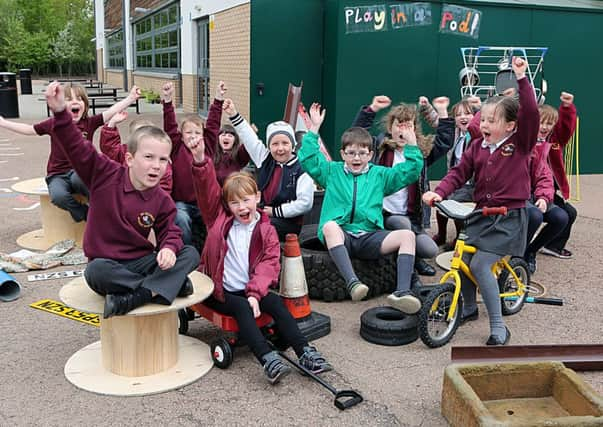Pupils get creative making child's play out of old junk


Play in a Pod at St Columba’s Primary School, Cupar, has embraced the idea that if you give youngsters the raw materials, their imaginations will do the rest.
Parents who have experienced a moment when their child has ignored a new toy and played with the box it came in instead will already have a grasp of the principle.
Advertisement
Hide AdAdvertisement
Hide AdAt St Columba’s the ‘raw materials’ could best be described as junk – tyres, wooden cable reels, pots and pans, an old tennis racket, guttering and road signs, to list just a few of the items - that has been recycled and is reimagined in ever-changing scenarios at the pupils’ play sessions.
The interest in getting Play in a Pod came out of a series of visits to the school by Play on Wheels, a mobile play service operating in Fife and Dundee. which brings along scrap and other material.
P1/2 class teacher Margaret Quirie immediately saw how this type of free play helped her pupils develop important life skills.
“They were working together, challenging ideas, solving problems and taking risks,” Margaret said.
Advertisement
Hide AdAdvertisement
Hide Ad“The children absolutely loved it and had so many different experiences with the equipment Play on Wheels brought with them.”
The biggest challenge for Margaret when she introduced the concept to the children was stepping back and letting the pupils lead the play.
“It was difficult at first not to make suggestions but I could see immediately how the children were using their imaginations, from making music or pretending to be in an office.”
The school decided to make it a permanent fixture and bought a container to be the ‘pod’ and as well as buying some materials, a letter was sent out to parents asking them for donations of suitable junk.
Advertisement
Hide AdAdvertisement
Hide AdPupils helped sort through the material, doing risk assessments on safety and the janitors helped out by tackling things like sharp edges to make them safe.
The theory behind playing with ‘loose parts’ is that it allows children to be more creative and inventive, with loose parts being defined as things that can be moved, carried, combined, redesigned, lined up, taken apart and put together again, and which have no specific directions.
In a pilot study of Play in a Pod in Dundee, the results included better behaviour and less arguing, the children were more imaginative and excited and those who might otherwise find it hard to integrate, excelled when playing with the pod.